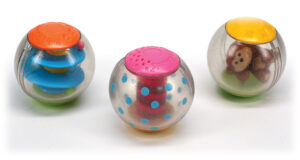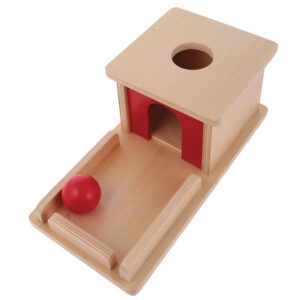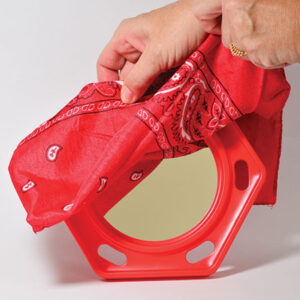Problem-solving, Object inquiry skills
A young infant plays with a ball of his/her choice.



Be Prepared: Select clear activity balls with objects inside that provide visual interest. Balls that are two and a half inches in diameter are appropriately sized for this age.
[Hold a nonmobile infant on your lap and invite him/her to play with a ball. Provide support for his/her head, neck, and torso as needed. Some infants will be able to sit erect with one of your hands supporting his/her chest and torso. Use the infant’s name as you talk with him/her and offer a few moments for the infant to get comfortable.]
 [Hold two balls in your palm about 12 inches from the infant. Allow ample time for the infant to look at the balls. Observe whether one ball seems to attract his/her attention. Give just enough assistance for the infant to get ahold of the ball he/she seems to prefer.
[Hold two balls in your palm about 12 inches from the infant. Allow ample time for the infant to look at the balls. Observe whether one ball seems to attract his/her attention. Give just enough assistance for the infant to get ahold of the ball he/she seems to prefer.
Describe the ball chosen by the infant. Example: “You looked at this ball. Then you reached for the ball. Something is spinning inside the ball.”
Give the infant time to explore the ball. If the ball drops, pick it up and hold it for the infant to see. Tip the ball to activate the moving toy inside. Point to and comment on the moving part inside. Example: “A little toy is moving inside our ball.”
If the infant remains interested, offer another set of two balls: the one not selected at the beginning of the activity and the third ball not initially offered. Help the infant select one of the balls for exploration, using procedures described above. Describe the selection and the infant’s actions with the ball.]
[Briefly describe what happened, pointing to balls involved in the activity. Example: “You looked at two balls. The balls have toys that move inside. You reached for one of the balls. You used your hands and your mouth to find out about the ball.”]
Infants will differ in how much they look at the two ball possibilities. You may wish to briefly and gently shake each ball separately so it is clear there are two balls. If you hold two balls stationary in your hand during the presentation, a young infant may think the two balls form one object. Most infants will look at the ball and feel the shape and hardness with their mouth. Some infants may look closely at the inside of the ball, especially if the moving part has strong visual appeal. Some infants may tire after exploring one ball. Infants sometimes begin to fuss after stimulation and need a structured calm down time. End the activity by talking to the infant and repositioning him/her if needed. Standing and holding the infant as you shift your weight from one foot to the other in a sway motion can help some infants become calm. Other infants are attuned to sound and begin to calm when you talk to them quietly.
Extra support
Enrichment
Problem-solving
An older infant explores an object permanence box with a ball of his/her choice.




 Sit on the floor next to an infant and invite him/her to play a game with you. Place the object permanence box on the floor so the infant can easily see the box, including the tray portion of the toy. Point to and demonstrate features of the box as you describe the hole, door, and tray. Infants may be interested in looking into the box or reaching into its hole. Imitate the infant’s action. Affirm and describe the infant’s actions. Examples: “You can reach into our box.” “You can look in our special box. The box is empty.”
Sit on the floor next to an infant and invite him/her to play a game with you. Place the object permanence box on the floor so the infant can easily see the box, including the tray portion of the toy. Point to and demonstrate features of the box as you describe the hole, door, and tray. Infants may be interested in looking into the box or reaching into its hole. Imitate the infant’s action. Affirm and describe the infant’s actions. Examples: “You can reach into our box.” “You can look in our special box. The box is empty.”
Next, set the two balls in front of the infant, one at a time, and encourage him/her to select one. The infant may be excited to put the ball through the hole before you describe his/her choice. Describe the infant’s pick and actions. Example: “Marco, you reached for the white ball right away. Then you dropped the ball into the hole!”
After a ball is put in the hole, the infant may look into the box through the top or may see the ball roll out the door onto the tray. Allow time for the infant to figure out what has happened. If the infant does not reach for the ball on the tray, ask him/her “Where did the ball go?” Use hand gestures to complement your words. Wait for the infant to respond.
Describe things the infant sees. Example: “Diego, your ball rolled out. There it is!”
Repeat the sequence a few times, drawing attention to the ball going in the hole and out the little door.
This activity supports cognitive development in two ways: the infant is encouraged to make a choice between two balls and to explore what happens to a ball when it is placed in a special box. Understanding that an object exists when it cannot be seen (known as object permanence) takes time to develop. Look carefully for signs of its development in the infant and provide appropriate support. Example: Demonstrate how the box works (see Extra Support tip) if it appears the infant is confused about how a ball can be dropped in the hole of the box.
The infant may be interested in dropping a ball in the hole but not in looking for it. Ask where the ball went, as suggested in the activity plan description, but do not push the question if the infant continues to show little interest in discovering where the ball went. The development of object permanence cannot be hurried. Simply talk with the infant about his/her version of the activity, giving words to each action.
If an infant shows no interest in the box, use the balls to play with him/her in other ways, such as handing them back and forth or rolling. Offer the infant two balls and encourage him/her to select one.
Extra support
Enrichment
 Materials Needed: small toys, cloth, mirror, small dish, stacking ring, books with flaps (such as Where’s Spot? by Eric Hill), laundry basket, lightweight ball, cardboard box
Materials Needed: small toys, cloth, mirror, small dish, stacking ring, books with flaps (such as Where’s Spot? by Eric Hill), laundry basket, lightweight ball, cardboard box
Play Peekaboo with a nonmobile infant during care routines. During playtime, draw an infant’s attention to a partially covered toy and lift the cover. Another day, play a peek game with a mirror. Cover a small mirror with a cloth and then remove the cover so the infant can see himself/herself.
For an early mobile infant, partially cover a toy for the infant to discover. Place a small dish over a stacking ring. Share books with flaps, such as Where’s Spot? by Eric Hill.
Cut 1–2 holes in the top of a cardboard box. At one end, cut an opening where infants may see and retrieve toys. Provide balls to drop through the holes. Mobile infants will enjoy dropping balls and other small toys into the top of the box and retrieving them from the side.
Materials Needed: large mailing tubes, balls or small vehicles, toy moose, Animal Camouflage by Sarah Dennis, Animals in Camouflage by Phyllis Limbacher Tildes
Reinforce object permanence understandings of toddlers and preschool-age children with large mailing tubes they can use with balls or small vehicles. Children may enjoy making tunnels with tubes.
Preschool-age and older children enjoy games played repeatedly. A fun way to begin the week is Moose is Missing, a game that involves hiding a toy moose and celebrating when children find the moose. Children also will enjoy taking a turn to hide the moose toy.
School-age children may be interested in learning about how animals use camouflage to hide. The books Animal Camouflage by Sarah Dennis and Animals in Camouflage by Phyllis Limbacher Tildes offer useful information and pictures. ELM’s activity plans in Science for preschool-age children also offer an introduction to animal camouflage.